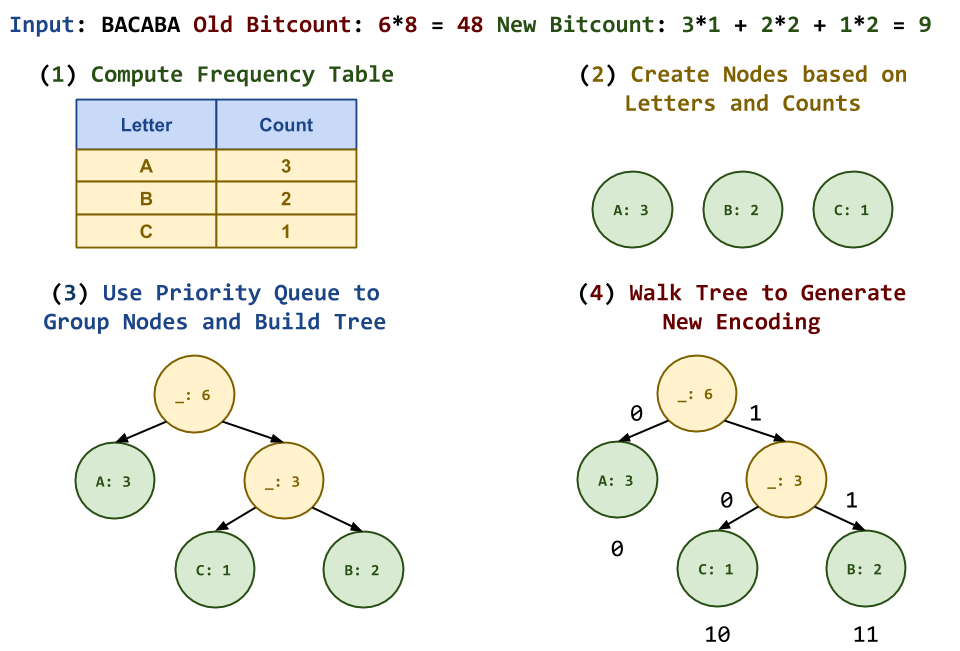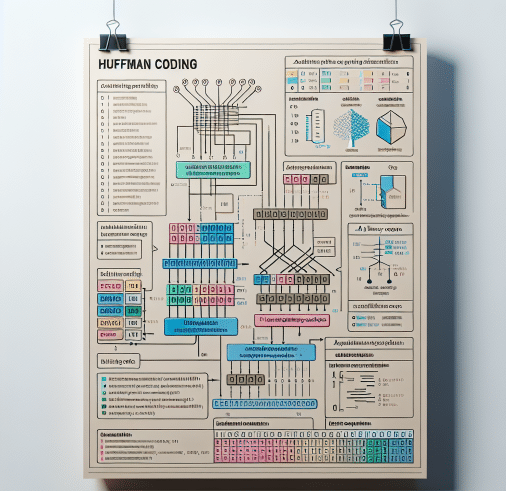Unlock the mystery of Huffman Coding with real-world examples and master this powerful data compression technique once and for all.
Table of Contents
Introduction to Compression Magic
We’ll start with a fun explanation of how computers use compression to store information in a way that takes up less space, just like how you can pack a suitcase to fit more toys!
Compression algorithms are like magic tricks that computers use to make big files smaller. Imagine you have a big toy box, and you want to fit more toys inside. Compression helps the computer squish the toys together so they take up less room.
Data encoding is like turning regular words and pictures into a secret code that only the computer understands. It’s like speaking in a secret language that saves space!
Lossless compression is a special kind of magic that makes sure nothing gets lost when we pack things up. It’s like putting your toys in a box, and when you open it again, all your toys are still there, just like before!
What is Huffman Coding?
Have you ever wondered how computers can store so much information in just a little space? Well, that’s where compression algorithms like Huffman Coding come in! It’s like a secret code that helps computers pack information tightly, just like how you might squish your toys into a small bag to bring them all on a trip.
The Secret Language of Computers
Huffman Coding is like creating a secret language that only the computer understands. It takes regular information, like words or pictures, and turns them into a special code that takes up less room. It’s a bit like speaking in a secret code that only you and your computer friend can understand!
Why Use Huffman Coding?
Imagine you have a big bookshelf full of books, but you want to make room for more toys. Huffman Coding helps computers save space by turning information into smaller secret codes. This way, the computer can store more pictures, videos, and games without taking up too much room.
Building the Huffman Tree
Before we dive into the world of Huffman Trees, let’s first understand what a binary tree is. Imagine a family tree, but for computer information! In a binary tree, each “parent” node can have up to two “child” nodes, creating a branching structure that helps organize data efficiently.

Creating the Tree Step-by-Step
Now that we know what a binary tree is, let’s explore how a special kind of tree, called the Huffman Tree, is crafted. Creating a Huffman Tree is like following a recipe to bake cookies – it involves specific steps to turn regular information into a secret code that takes up less space.
The process begins with analyzing the frequency of each character in the data we want to compress. Characters that appear more frequently are assigned shorter codes, while less common characters get longer codes. This way, the most common characters are represented by shorter sequences, making the overall code more efficient.
Next, we combine the two least frequent characters into a new node, with a weight equal to the sum of their frequencies. This new node becomes a parent node, with the original characters as its children. This merging process continues until all characters are connected in a single tree structure.
By following these steps, we create a Huffman Tree that serves as a map for translating regular information into a compact, secret code using variable-length binary sequences. This tree is the key to unlocking the magic of Huffman Coding and achieving efficient data compression.
The Magic of Encoding and Decoding
In this section, we will explore how the fascinating process of encoding and decoding using Huffman Coding helps computers store information efficiently.
Turning Things into Code
Imagine you have a special code that only you and your best friend understand. That’s what encoding does with information! Using the Huffman Tree, we can take regular words, numbers, or even pictures and turn them into a secret code. This code is much shorter than the original information, saving a lot of space.
From Code Back to Normal
Now, let’s reverse the process and decode the secret code back into its original form. Just like deciphering a secret message, the computer uses the Huffman Tree to translate the code back into words, numbers, or pictures that we can understand. It’s like magic!
Why Lossless Compression is Awesome
Lossless compression is like packing your suitcase without leaving anything behind! When we use lossless compression, we make sure that every single piece of information is carefully packed away. Just like when you pack your toys for a trip, you want to make sure nothing gets lost along the way. With lossless compression, we can unpack the suitcase (or decode the information) and find everything exactly as we packed it.

Comparing to Other Compression
Let’s imagine different ways of packing your toys for a trip. Some methods might squish your toys together, making them a little bit smaller but still keeping all the pieces. This is similar to how lossless compression works – it keeps everything intact while making it more compact. Other methods, like lossy compression, might leave some toys behind to save space. Huffman Coding, with its focus on preserving every detail, stands out as a cool and useful method that ensures nothing is lost in the packing process.
Putting It All Together
In our journey through the world of compression magic, we’ve uncovered the secrets behind Huffman Coding and how it helps computers save space. Let’s recap all the amazing things we’ve learned!
The Secret Language of Computers
Imagine creating a secret language that only computers can understand. That’s what Huffman Coding does! It takes regular information and transforms it into a special code that saves precious space.
Why Use Huffman Coding?
Saving space is crucial in the world of computers. Huffman Coding is like a superhero that swoops in to make sure our data doesn’t take up unnecessary room. It’s efficient, smart, and super cool!
What’s a Binary Tree?
Binary trees are like family trees for computer information. They show how different pieces of data are related to each other, helping us organize and compress data efficiently.
Creating the Tree Step-by-Step
Just like following a recipe to bake cookies, creating a Huffman Tree involves a series of steps. Each step is like adding a new ingredient to the mix, until we have a perfectly compressed code ready to use.
Turning Things into Code
Using the Huffman Tree, we can turn everyday words and images into a secret code that only computers can understand. It’s like sending a message in a bottle, but in a language that only the recipient can decipher.
From Code Back to Normal
Once our data is encoded, the computer can easily decode it back to its original form. It’s like translating a secret message back into plain language so we can read and understand it again.
No Piece Left Behind
Lossless compression, like Huffman Coding, ensures that nothing gets left behind when we pack our data into a smaller space. It’s like fitting all your toys back into the suitcase without losing a single one!
Comparing to Other Compression
While there are many ways to compress data, Huffman Coding stands out for its efficiency and accuracy. It’s like choosing the best tool for the job, ensuring that our data stays safe and intact.
By mastering the art of Huffman Coding, we’ve unlocked a powerful tool that helps computers work smarter and faster. It’s like having a superpower that allows us to save space and store information efficiently. So next time you see a compressed file, remember the magic of Huffman Coding that made it all possible!
Frequently Asked Questions (FAQs)
We’ll answer some common questions you might have about Huffman Coding and how it works.
What’s the difference between lossless and lossy compression?
We’ll explain the difference in a way that’s easy to understand, like comparing different ways of packing your clothes.
Can Huffman Coding be used for videos?
Here, we’ll talk about whether we can use this cool coding method for videos too.
Why don’t we use Huffman Coding for everything?
We’ll discuss why sometimes other methods are used instead of Huffman Coding.
